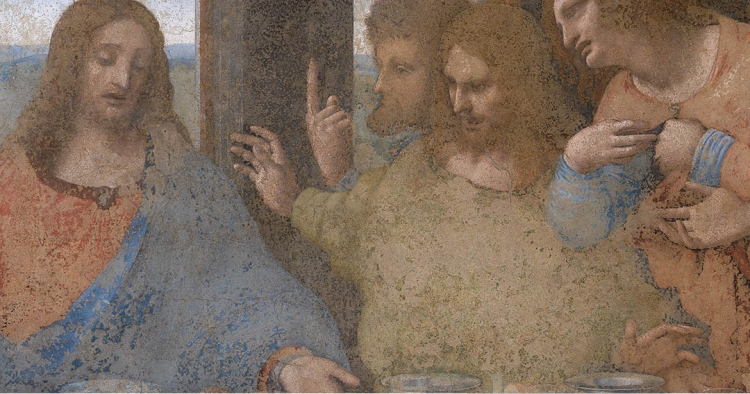Given that it’s Easter weekend I thought Santiago in the art of the Last Supper might make an interesting post. When we think of artistic representation of the Last Supper, the first painting that comes to mind is undoubtedly Leonardo da Vinci’s fresco in the Dominican convent of Santa Maria delle Grazie, in Milan.[1] But can you spot Santiago/St James in it? Zoom in and give it a shot.

Can’t find him? Don’t worry, neither did I. In much of medieval and renaissance art apostles are recognisable by particular symbols, a kind of visual vocabulary that allowed anyone of any language or no literary ability to identify a statue or painting of a saint. Peter frequently has a set of keys, Mary Magdalene carries an urn or ointment box, and Bartholomew, who was supposedly flayed alive, even carries his own skin! Santiago, of course, is frequently recognisable by the shell, broad hat, and pilgrim staff. But in representations of the Last Supper, these symbols are frequently absent, and it’s hard to identify one apostle from another within a ‘crowd’ of them (is there’s a collective noun for apostles?!).
A few different incidents at the gathering were seized upon by artists over the centuries as their subject, such as the washing of the feet, the initiation of the eucharist, and – in Leonardo’s case – the dramatic moment in which Jesus announces that one of them would betray him. For renaissance artists who wanted to experiment with representing human emotion, this was an ideal opportunity to depict a variety of sensations: disbelief, anger, incredulity, confusion and resignation. In Leonardo’s Last Supper there’s a triad of figures immediately to Jesus’ left (our right), where a largely-obscured figure is pointing upwards (possibly ‘Doubting’ Thomas) and the third figure on Jesus’s left (believed to be Philip) seems to be pointing at himself and pleading with Jesus as if to say ‘Don’t say it’s me!’ Identification in this case is possible thanks to notes in Leonardo’s surviving notebooks and sketches.

So where is James? He’s the third figure in this triad, sitting directly to Jesus’s left. His position – the physically closest apostle to Jesus – is unsurprising, as the gospels indicate he was within the ‘inner circle’ of the disciples (I’ve discussed this here in a history of the Camino). Decomposition of the painting has made most of his body a blur, but he seems to have open and outstretched hands, his right reaching up toward Jesus’s shoulder and his left almost touching the table. It’s hard to read his expression, but he appears open-mouthed with eyes downcast. Is he holding back Thomas and Philip? Is he shouting ‘Whoa! Back off guys!’? Is he remonstrating with Jesus? Not unlikely, given Jesus had nicknamed him ‘Son of Thunder’ on account of his temper.
[1] The official page of the museum: https://cenacolovinciano.org/en/museum/the-works/the-last-supper-leonardo-da-vinci-1452-1519